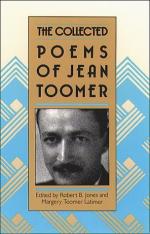|
This section contains 9,328 words (approx. 32 pages at 300 words per page) |

|
SOURCE: “Raising Cane on the Theoretical Plane: Jean Toomer's Racial Personae,” in Cultural Difference & the Literary Text: Pluralism & the Limits of Authenticity in North American Literatures, edited by Winfried Siemerling & Katrin Schwenk, University of Iowa Press, 1996, pp. 49-74.
In the following essay, Lindberg discusses Toomer's theories of racial and national identity.
At least as early as 1924, when Alain Locke was constructing the New Negro and putting together his anthology, Jean Toomer, already burned by his debut as a “Negro writer,” had a counter-definition—more properly a refusal of definition—of the possibilities for the Negro in America. By making conscious the conditions of his or her history and current predicament of objectification, Toomer's Negro is not to be fixed as “New” or even as reconstructed. Rather, just like the “individual” by Emersonian and Whitmanian lights, Toomer's Negro is projective and radically skeptical in rejecting all “arbitrary figures” presented...
|
This section contains 9,328 words (approx. 32 pages at 300 words per page) |

|


